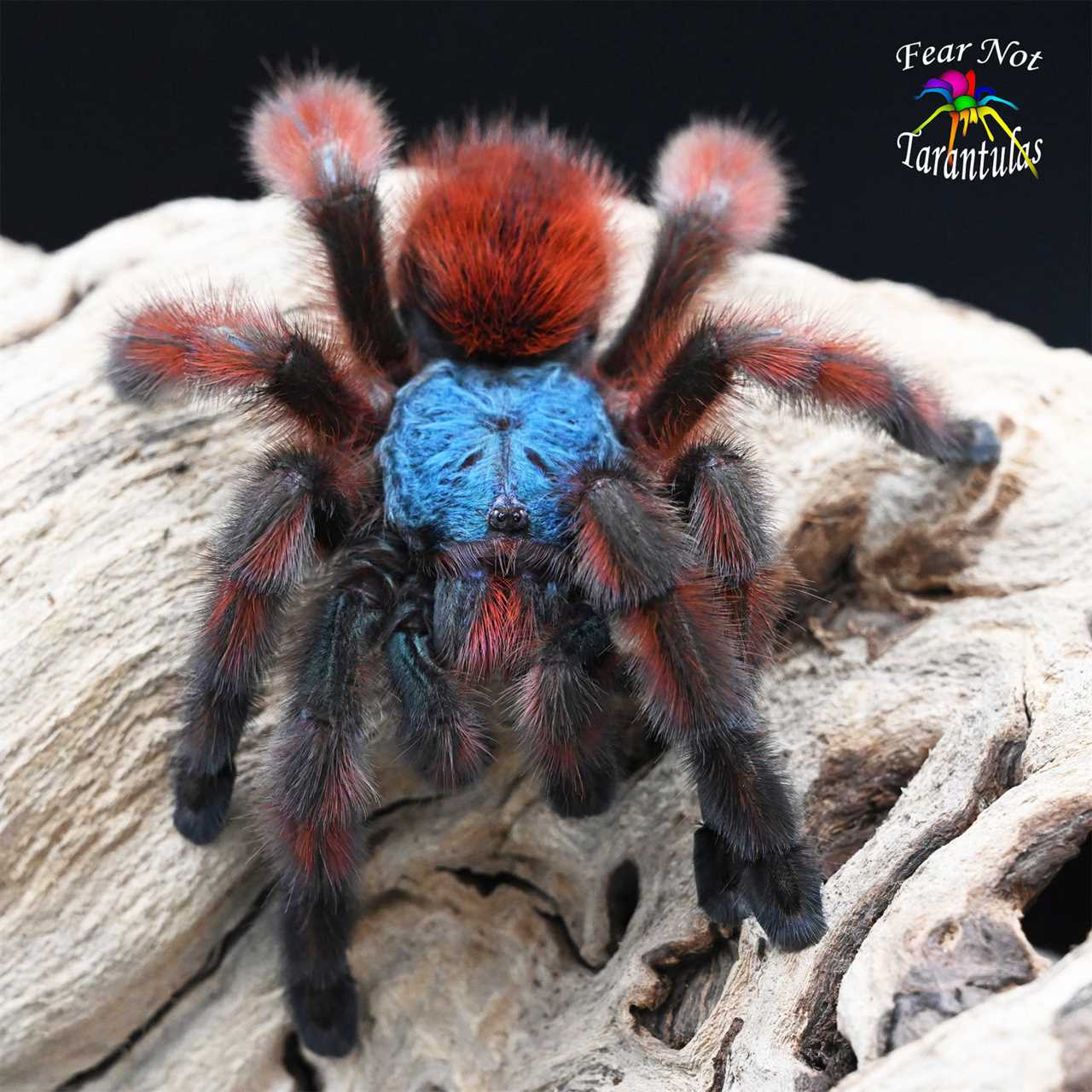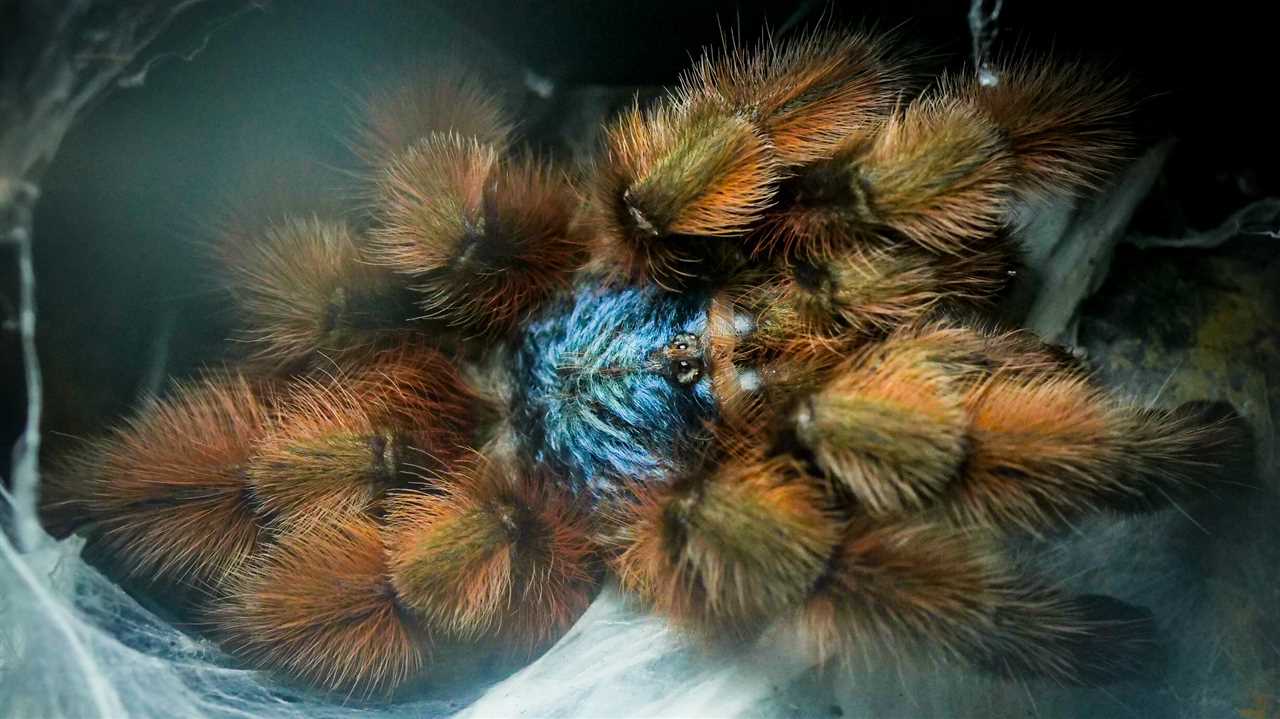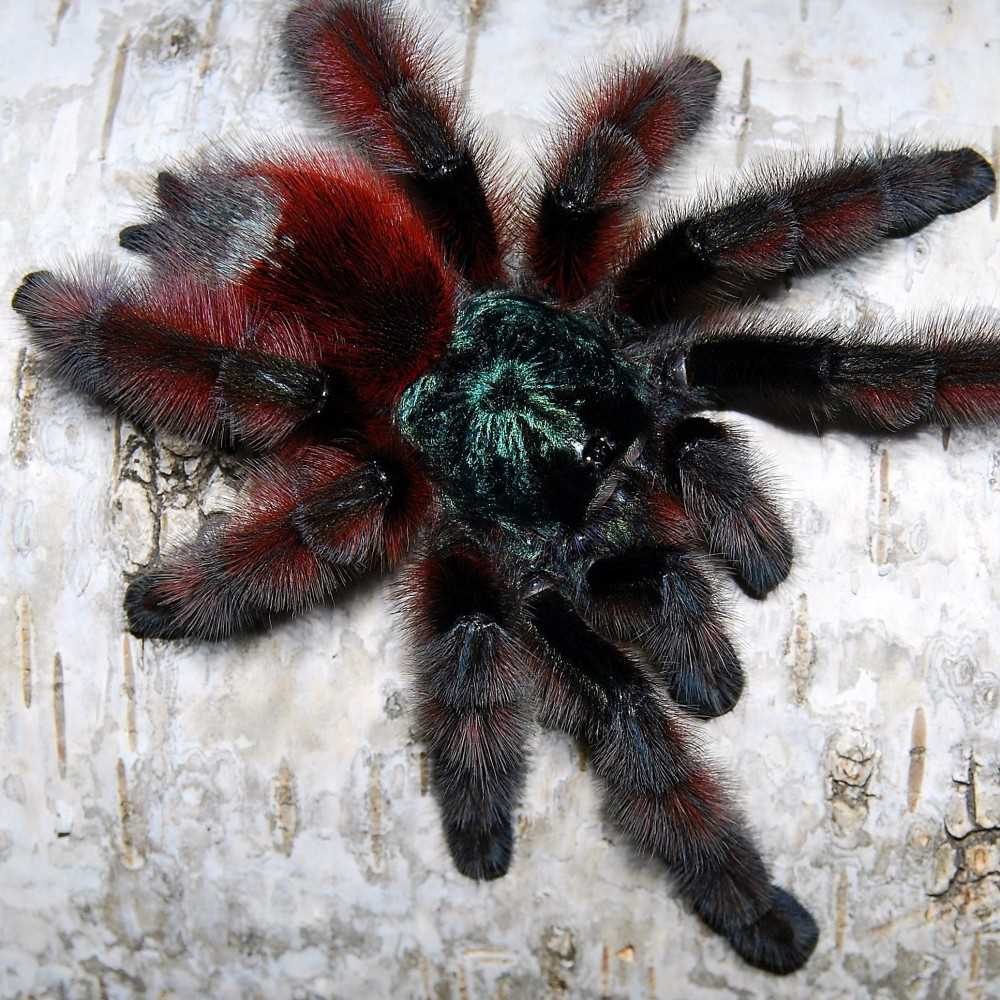
Avicularia versicolor: Origin and Appearance
This species has a unique coloration that sets it apart from other tarantulas. Juvenile Avicularia versicolor individuals display vibrant blue coloration on their legs and abdomen, while adults transition to a striking green color. Their carapace remains black with orange hairs along the edges.
Size and Lifespan

The Avicularia versicolor tarantula is considered a medium-sized tarantula, with adult females reaching a maximum legspan of around 5 to 6 inches (13-15 cm) and adult males being slightly smaller. They have a relatively long lifespan compared to other tarantula species, with females living up to 12 years and males living around 5-7 years.
Hair and Fangs
Like other tarantula species, Avicularia versicolor has tiny hair called urticating hairs on their abdomen, which they can flick as a defense mechanism. These hairs are irritating and can cause mild irritation to humans, but are more of a threat to predators. Their fangs are used to inject venom into their prey, but their venom is not medically significant to humans.
With its vibrant coloration and intriguing features, the Avicularia versicolor is a tarantula that captivates both tarantula enthusiasts and newcomers to the hobby alike.
Avicularia versicolor: Habitat and Natural Behavior

Avicularia versicolor is a nocturnal species, meaning that it is most active during the night. During the day, it will hide in its burrow or find a sheltered spot in the foliage to rest. At night, it will emerge to hunt for prey, which consists mainly of insects such as crickets, moths, and beetles.
One interesting aspect of the Avicularia versicolor’s natural behavior is its ability to change color. It is believed that this adaptation helps them blend into their surroundings and avoid predation. When they are calm and undisturbed, their colors are more vibrant. However, when they feel threatened or agitated, they can change their colors to a more muted tone, allowing them to become less visible and hiding from potential predators.
Overall, the Avicularia versicolor is a fascinating species with unique habitat and natural behaviors. Its arboreal nature, vibrant coloration, and web-building abilities make it a popular choice among tarantula enthusiasts.
Avicularia versicolor: Care Guide and Requirements
Enclosure Setup
Substrate-wise, a mixture of peat moss, coco fiber, and orchid bark works well as it retains moisture while also allowing for drainage. Maintaining a humidity level of around 70-80% is crucial for the health of your tarantula. You can achieve this by misting the enclosure daily or by using a humidity controller.
Temperature and Lighting
Avicularia versicolor prefers slightly cooler temperatures compared to other tarantula species. The ideal temperature range for this species is around 70-78°F (21-25°C). It is crucial to avoid extreme temperature fluctuations or prolonged exposure to high temperatures, as it can be harmful to their health.
Feeding and Hydration
Avicularia versicolor is an opportunistic feeder and will eat a variety of prey items, including crickets, roaches, and other small invertebrates. Offer them appropriately sized live prey once or twice a week. It is crucial to avoid overfeeding, as obesity can become a problem for these tarantulas.
Hydration is equally important for Avicularia versicolor. You can provide a shallow water dish filled with clean, chlorine-free water that is easily accessible for your tarantula. Additionally, mist the enclosure regularly to increase humidity and allow your spider to drink droplets of water from the webbing.
Handling and Maintenance
Avicularia versicolor is known for its docile and calm nature, making them relatively easy to handle. However, excessive handling should be avoided as it may cause stress to the tarantula. When handling, it is essential to be gentle and avoid sudden movements that may startle the spider.
Regular maintenance of the enclosure is necessary to ensure the tarantula’s well-being. This includes spot cleaning the enclosure to remove any uneaten prey or waste, as well as monitoring and adjusting humidity and temperature levels as necessary.
Avicularia versicolor: Common Health Issues and Tips for Prevention
1. Mites: Mites are tiny parasites that can infest the spider’s enclosure and the tarantula itself. They can cause irritation, itchiness, and stress to the avicularia versicolor. To prevent mites, regularly clean the enclosure and make sure to quarantine new additions to the enclosure before introducing them to the spider.
2. Dehydration: Avicularia versicolor requires a humid environment to thrive. If the enclosure does not provide enough moisture, the spider may become dehydrated. To prevent dehydration, mist the enclosure regularly, provide a water dish for the spider to drink from, and monitor the humidity levels using a hygrometer.
3. Molting issues: Molting is a natural process for tarantulas, including avicularia versicolor. However, molting issues can occur, such as difficulties shedding the old exoskeleton or getting trapped during the process. To prevent molting issues, make sure the spider has sufficient humidity and a proper hiding spot to molt undisturbed. Avoid handling the spider during the molting process.
4. Injuries: Accidental injuries can happen to avicularia versicolor if they fall from a height or get stuck in their enclosure. To minimize the risk of injuries, provide a suitable climbing area with secure branches and make sure the enclosure is escape-proof. Also, be cautious when handling the spider to avoid dropping it or causing unnecessary stress.
By being aware of these common health issues and implementing the necessary preventive measures, avicularia versicolor owners can ensure the well-being and longevity of their beloved tarantulas.
